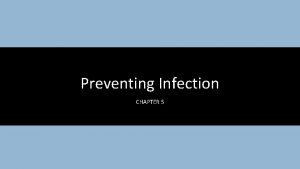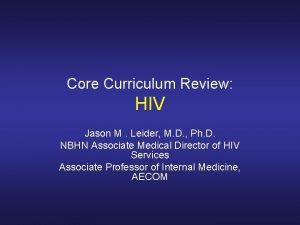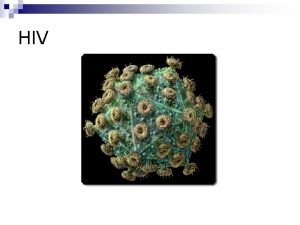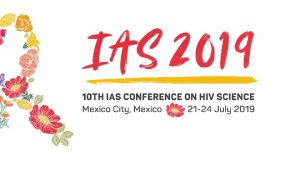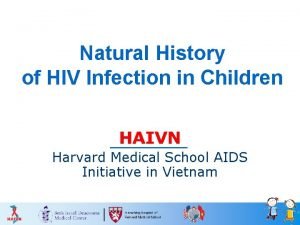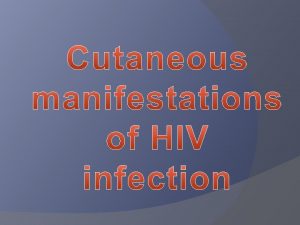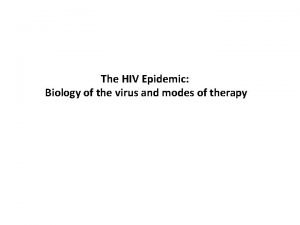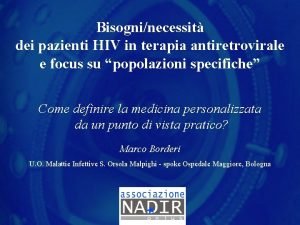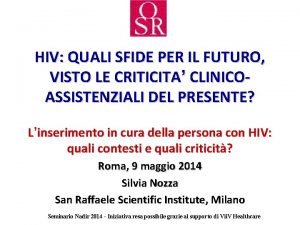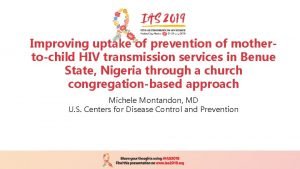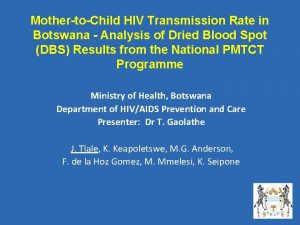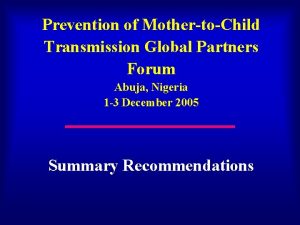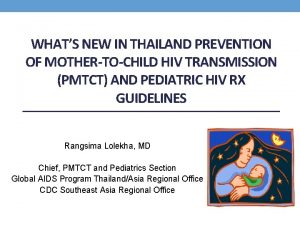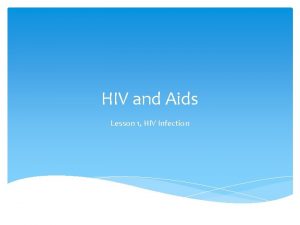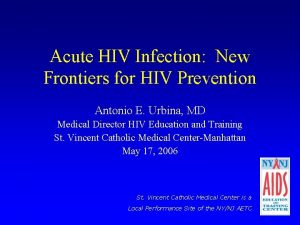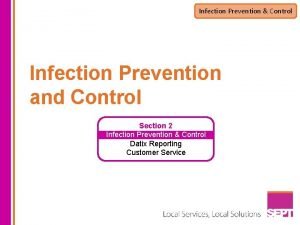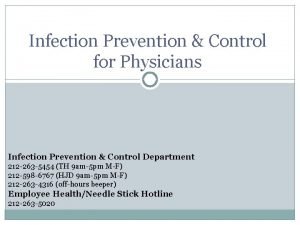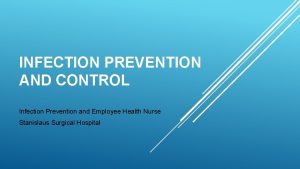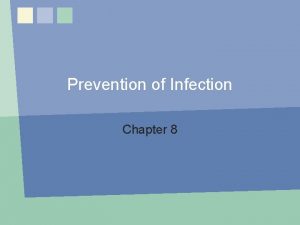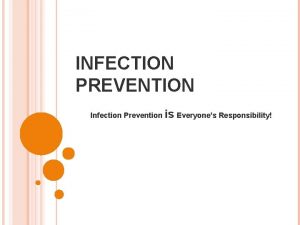Prevention of MothertoChild Transmission of HIV infection in
















- Slides: 16

Prevention of Mother-to-Child Transmission of HIV infection in Sri Lanka Presentation for the 8 th Task Force Meeting : Lao People’s Republic 23 -25 th November 2010 Dr Sujatha Samarakoon Consultant Venereologist / Focal Point ECS & PMTCT – National STD/AIDS Control Programme, Ministry of Health


HIV/AIDS situation in Sri Lanka Adult HIV prevalence rate <0. 1% - Sri Lanka has a low level HIV epidemic Number reported as at end September 2010 = 1285 ( females=518) Male : female ratio = 1. 5: 1 Cumulative AIDS deaths =212 Estimated PLHIV by 2009 = 3000 Estimated of number of Pregnant women with HIV (2010) = 50 Estimated number of pregnant women in need of ART (2010)=42 Number of reported cases of Vertical Transmission =44

The PMTCT Strategy… Prevention of transmission of HIV in young people & women of childbearing age Prevention of unintended pregnancies in HIV + women Prevention of transmission from an HIV positive woman to her infant Care and support for the mother & her family

PMTCT activities Girl child – PMTCT included in the school education programme of SP Women in child bearing age – Preconception package of Family Health Bureau (FHB) included PMTCT & ECS, Work plan of women’s health of FHB Antenatal mothers Antenatal care package of FHB includes PMTCT& ECS PHC staff training includes PMTCT & ECS ( PHNS, PHI, PHM, Labour room staff) should be now included in the curriculum Male partner – Parent craft classes Sensitization meeting for VOG/SR/SHO - 4 meetings NSACP member of the Perinatal Mortality Review Committee of DMH

PMTCT target for SL 70% of pregnant mothers accepting VCT, 60% of HIV 70%infected mothers detected, and 80% of infants born to HIV infected mothers free from HIV Antenatal syphilis screening for all pregnant women attending antenatal services

PMTCT activities In three selected areas, pilot programs are being carried out One of the leading Maternity Hospitals is offering routine HIV testing as Standard of Care One hospital offering – Opt out One MOH area offering Opt out (62, 000 samples tested 2004 -2009 and only 6 were positive giving a rate of 0. 02%)


Antenatal HIV testing profile (2000 -2009) Year Number tested Number positive Percent 2000 30, 906 3 0. 01 20, 409 0 0 2002 17, 601 0 0 2003 20, 286 1 0. 01 2004 14, 529 2 0. 01 2005 14, 476 0 0 2006 13225 0 0 2007 8648 1 0. 01 2008 12239 3 0. 02 2009 13, 475 2 0. 02 HIV prevalence among AN mothers very low

HIV + women - Goals of Prenatal care Optimize HIV positive woman’s physical and psychological well being Prevent vertical transmission of HIV Minimize maternal risks Optimize neonatal well being Prepare for or prevent next pregnancy

PMTCT services Routine obstetric care – PHC/ VOG/Hospital staff Clinical and immunological assessment of HIV infection – Venereologist/MO-STD Provision of ART – Venereologist/MO-STD/VOG Provision of safe delivery practices – VOG/ anesthetist Provision of safe feeding practices- paediatrician/VOG/MOSTD

ARV in Pregnancy For her own health or as prophylaxis as per new WHO guidelines Prophylaxis – Option A or B ?

ARV for infant As per new WHO guidelines

Breast feeding / Replacement feeding – If no AFASS then exclusive breastfeeding for 6 months

Guidelines for Management of HIV Infection in Pregnancy Preparation in progress

Thank you
 Chapter 19 disease transmission and infection prevention
Chapter 19 disease transmission and infection prevention Puncture resistant container
Puncture resistant container Chapter 19 disease transmission and infection prevention
Chapter 19 disease transmission and infection prevention Primary prevention secondary prevention tertiary prevention
Primary prevention secondary prevention tertiary prevention Stakeholders in hiv prevention
Stakeholders in hiv prevention Global hiv prevention coalition
Global hiv prevention coalition Chapter 16 infection control and standard precautions
Chapter 16 infection control and standard precautions Define infection prevention chapter 5
Define infection prevention chapter 5 Hiv
Hiv Hiv in adults
Hiv in adults Hiv test window period
Hiv test window period Risk of blood transfusion
Risk of blood transfusion Causative organism of hiv/aids
Causative organism of hiv/aids Hiv reverse transcription
Hiv reverse transcription Hiv
Hiv Hiv
Hiv Fiebig hiv
Fiebig hiv







